
Joseph William Ashy, is a retired United States Air Force (USAF) general who was commander in chief of North American Aerospace Defense Command and United States Space Command, and commander of Air Force Space Command, headquartered at Peterson Air Force Base, Colorado. As commander of NORAD, General Ashy was responsible for the air sovereignty of the United States and Canada, as well as for providing tactical warning and attack assessment. As USCINCSPACE, he commanded the unified command responsible for directing space control and support operations including theater missile defense. As COMAFSPC, he directed satellite control, warning, space launch and ballistic missile operations missions through a worldwide network of support facilities and bases.

Lieutenant General Winfield Wayne Scott Jr. was the tenth Superintendent of the United States Air Force Academy in Colorado. Thereafter, he was appointed Superintendent of the New Mexico Military Institute, a public military high school and junior college that is supported by the State of New Mexico, located in Roswell, New Mexico.
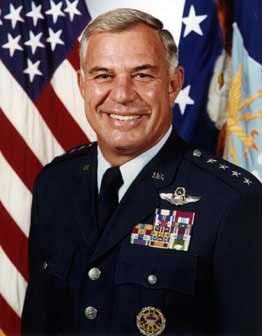
General John George Lorber was a retired four-star general in the United States Air Force (USAF). He served as commander of Pacific Air Forces, Hickam Air Force Base, Hawaii. As commander, he had responsibility for USAF activities spread over half the world in a command that supports 44,000 airmen serving principally in Hawaii, Alaska, Guam, Republic of Korea and Japan.

General James Burr Davis is a retired U.S. Air Force general and was chief of staff, Supreme Headquarters Allied Powers Europe in Mons, Belgium.

Carlos Maurice Talbott was a United States Air Force officer who attained the rank of lieutenant general and was vice commander in chief of the Pacific Air Forces, headquartered at Hickam Air Force Base.

Jimmie Vick Adams is a retired four-star general in the United States Air Force (USAF). He served as commander in chief, Pacific Air Forces (CINCPACAF) from 1991 to 1993.
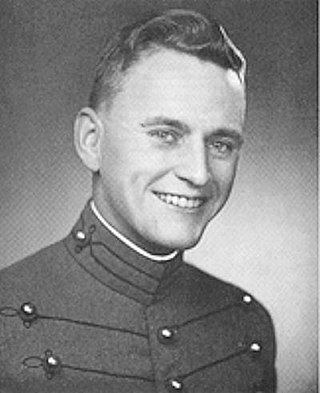
Brigadier General William D. Curry Jr was a retired United States Air Force officer. He was a command pilot with over 6,500 flying hours, serving in World War II, the Korean and Vietnam Wars.

Winfield Scott Harpe was a United States Air Force officer who served during the Vietnam War and Cold War.
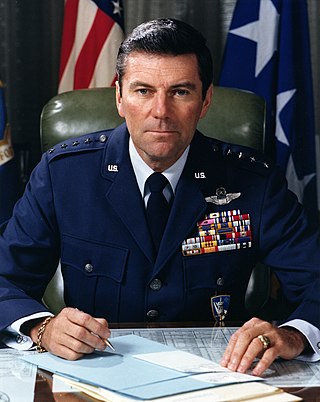
William John Evans was a general in the United States Air Force and commander of Allied Air Forces Central Europe.

Robert Dale Russ was a United States Air Force (USAF) general and commander of Tactical Air Command.
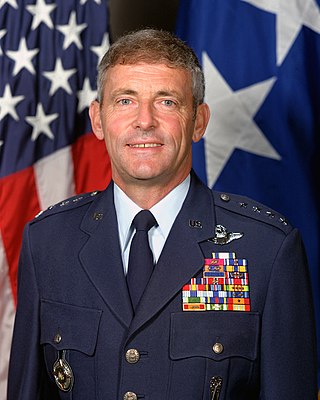
James P. McCarthy is a retired United States Air Force general. His last assignment before retirement was as Deputy Commander in Chief of the United States European Command. In retirement, McCarthy has served on a number of corporate and government advisory boards, as well as serving as the ARDI Professor of National Security at the United States Air Force Academy.

Lieutenant General Winton Whittier Marshall was a United States Air Force general and flying ace. He was deputy commander in chief, U.S. Readiness Command, with headquarters at MacDill Air Force Base in Florida before retiring in 1977.

James Montgomery Breedlove was an American air force major general who was commander, U.S. Air Force Southern Air Division of the Tactical Air Command and deputy commander in chief, United States Southern Command, Quarry Heights, Canal Zone.
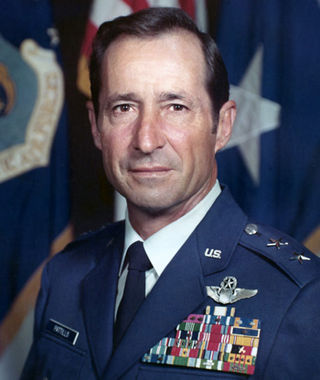
Charles Curtis Pattillo, also known as Buck Pattillo, was an American Air Force lieutenant general who was deputy commander in chief, U.S. Readiness Command and vice director of the Joint Deployment Agency with headquarters at MacDill Air Force Base, Florida. He died in May 2019 at the age of 94.

George Gilmer Loving Jr. was a United States Air Force lieutenant general who served as commander, United States Forces Japan and Fifth Air Force, with headquarters at Yokota Air Base, Japan. As commander, he was the senior United States military representative in Japan and responsible for all United States air units in Japan and the Republic of Korea.
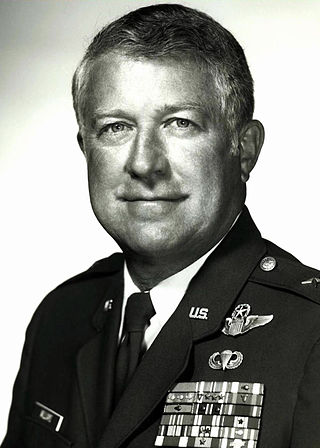
Gordon E. Williams is a retired United States Air Force officer. A command pilot with more than 4,000 flying hours, he flew numerous Air Force and Navy aircraft. Upon his retirement on 1 August 1988, he was the director for plans and policy, J-5, Headquarters United States European Command, Stuttgart-Vaihingen, West Germany.

Craven C. Rogers Jr. was a lieutenant general in the United States Air Force who served as deputy commander in chief of the U.S. Central Command at MacDill Air Force Base, Florida. The command was tasked with achieving United States national objectives in Southwest Asia, the Persian Gulf, and the Horn of Africa. Rogers was born in 1934, in Galveston, Texas. He earned a Bachelor of Science degree in engineering from the U.S. Military Academy in 1957 and a master's degree in business administration from The George Washington University. He completed Squadron Officer School in 1962 and the Industrial College of the Armed Forces in 1973. Upon graduation from the academy he was commissioned as a second lieutenant in the Air Force. After completing pilot training in September 1958 he was assigned to Tactical Air Command at Williams Air Force Base, Ariz., for gunnery training in the F-86F. With the phaseout of the F-86F, Rogers transferred in June 1959 as an instructor pilot to Air Training Command, Vance Air Force Base, Oklahoma. He completed F-101A transition training in September 1964 and then was assigned as a tactical fighter pilot with the 91st Tactical Fighter Squadron, Royal Air Force Station Bentwaters, England. In 1965 his squadron became the first unit in the United States Air Forces in Europe to transition to the F-4. Rogers assumed duties in the Standardization and Evaluation Section of the 81st Tactical Fighter Wing at Bentwaters in November 1966. In September 1967 he transferred to Nellis Air Force Base, Nevada, where he completed the F-4 Fighter Weapons School. In January 1968 he was assigned to the 557th Tactical Fighter Squadron, 12th Tactical Fighter Wing, Cam Ranh Bay Air Base, South Vietnam, as a flight commander and squadron weapons officer. He subsequently served as the wing weapons officer and assistant chief of weapons and tactics for 12th Tactical Fighter Wing. He flew 255 combat missions and 435 combat flying hours in the F-4C. He returned from Southeast Asia in February 1969 and was assigned to the Fighter and Reconnaissance Manning Section, Air Force Military Personnel Center, Randolph Air Force Base, Texas. He became chief of the section in 1971. Upon graduation from the Industrial College of the Armed Forces in August 1973, Rogers became deputy commander for operations, 1st Tactical Fighter Wing, MacDill Air Force Base, Florida. In June 1975 he transferred to Headquarters United States Air Force, Washington, D.C., as chief, Tactical Division, Directorate of Operational Requirements, Office of the Deputy Chief of Staff, Research and Development. In July 1977 Rogers was assigned as vice commander of the 4th Tactical Fighter Wing, Seymour Johnson Air Force Base, North Carolina. In June 1978 he became commander of the wing. He returned to Air Force headquarters in July 1980 and served as military assistant to the secretary of the Air Force. From June 1983 to July 1985 he was commander of United States Air Forces Korea; commander, United Nations Command Air Component; and commander, 314th Air Division, with headquarters at Osan Air Base, South Korea. He also was commander of the Korean Air Defense Sector, director of readiness and combat operations, and chief of staff of the Air Component Command/Combined Forces Command. Rogers then transferred to Hickam Air Force Base, Hawaii, as vice commander in chief, Pacific Air Forces. In December 1986 Rogers returned to Osan Air Base as commander, 7th Air Force; deputy commanding general, U.S. Forces Korea (Seoul); and deputy commander in chief, United Nations Command (Seoul). He is a command pilot with 5,200 flying hours. His military awards and decorations include the Defense Distinguished Service Medal with oak leaf cluster, Distinguished Service Medal, Legion of Merit with two oak leaf clusters, Distinguished Flying Cross with oak leaf cluster, Bronze Star Medal, Meritorious Service Medal with oak leaf cluster, Air Medal with 13 oak leaf clusters, Air Force Commendation Medal, Korean Order of National Security Merit (Chunsu) and Korean Order of National Security Merit (Kuksun). He was promoted to lieutenant general January 1, 1987, with same date of rank. He retired on April 1, 1991, and died on August 4, 2016.

David R. Smith was a major general in the United States Air Force who served as Commander of the United States Air Force Reserve Command, Headquarters U.S. Air Force, Washington D.C., and commander, Headquarters Air Force Reserve, a separate operating agency located at Robins Air Force Base, Georgia. As chief of Air Force Reserve, he served as the principal adviser on Reserve matters to the Air Force Chief of Staff. As commander of AFRES, he had full responsibility for the supervision of U.S. Air Force Reserve units around the world. He was also commander of the 10th Air Force.
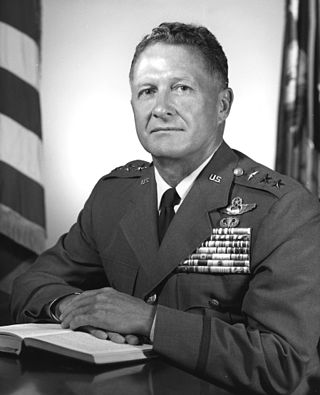
Gordon Marion Graham was a United States Air Force lieutenant general. Graham was a combat pilot who, during World War II was credited with 7 aerial victories making him a flying ace. He is credited with a further 9.5 aircraft destroyed on the ground. By the end of World War II, Graham had flown 73 combat missions in the P-51 Mustang.

Major General Robert W. Maloy was a United States Air Force officer who served in World War II and the Vietnam War.



















